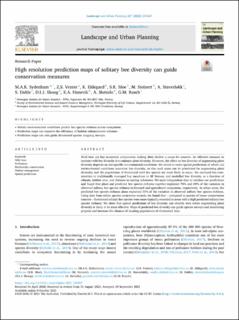| dc.contributor.author | Sydenham, Markus A. K. | |
| dc.contributor.author | Venter, Zander | |
| dc.contributor.author | Eldegard, Katrine | |
| dc.contributor.author | Moe, Stein Ragnar | |
| dc.contributor.author | Steinert, Mari | |
| dc.contributor.author | Staverløkk, Arnstein | |
| dc.contributor.author | Dahle, Sondre | |
| dc.contributor.author | Skoog, Daniel Ingvar Jeuderan | |
| dc.contributor.author | Hanevik, Kaj-Andreas | |
| dc.contributor.author | Skrindo, Astrid Brekke | |
| dc.contributor.author | Rusch, Graciela | |
| dc.date.accessioned | 2022-07-14T10:02:15Z | |
| dc.date.available | 2022-07-14T10:02:15Z | |
| dc.date.created | 2021-10-14T15:00:19Z | |
| dc.date.issued | 2021 | |
| dc.identifier.citation | Landscape and Urban Planning. 2021, 217 . | |
| dc.identifier.issn | 0169-2046 | |
| dc.identifier.uri | https://hdl.handle.net/11250/3005371 | |
| dc.description.abstract | Wild bees are key ecosystem components making their decline a cause for concern. An effective measure to increase wild bee diversity is to enhance plant diversity. However, the effect on bee diversity of augmenting plant diversity depends on site-specific environmental conditions. We aimed to make spatial predictions of where: (a) environmental conditions maximize bee diversity, so that such areas can be prioritized for augmenting plant diversity; and (b) populations of threatened wild bee species are most likely to occur. We surveyed bee communities in traditionally managed hay meadows in SE Norway and modelled bee diversity as a function of climate, habitat area, and distance to nesting substrates. We used independent data to validate our predictions and found that plant and predicted bee species richness together explained 76% and 69% of the variation in observed solitary bee species richness in forested and agricultural ecosystems, respectively. In urban areas, the predicted bee species richness alone explained 31% of the variation in observed solitary bee species richness. Using data from online species occurrence records, we found that – compared to species of lower conservation concern – threatened solitary bee species were more typically recorded in areas with a high predicted solitary bee species richness. We show that spatial predictions of bee diversity can identify sites where augmenting plant diversity is likely to be most effective. Maps of predicted bee diversity can guide species surveys and monitoring projects and increase the chances of locating populations of threatened bees. | |
| dc.language.iso | eng | |
| dc.title | High resolution prediction maps of solitary bee diversity can guide conservation measures | |
| dc.type | Peer reviewed | |
| dc.type | Journal article | |
| dc.description.version | publishedVersion | |
| dc.subject.nsi | VDP::Samfunnsøkonomi: 212 | |
| dc.subject.nsi | VDP::Economics: 212 | |
| dc.source.pagenumber | 12 | |
| dc.source.volume | 217 | |
| dc.source.journal | Landscape and Urban Planning | |
| dc.identifier.doi | 10.1016/j.landurbplan.2021.104267 | |
| dc.identifier.cristin | 1946029 | |
| dc.relation.project | Klima- og miljødepartementet: 2018/72806 | |
| dc.relation.project | Norges forskningsråd: 160022 | |
| cristin.ispublished | true | |
| cristin.fulltext | original | |
| cristin.qualitycode | 2 | |
